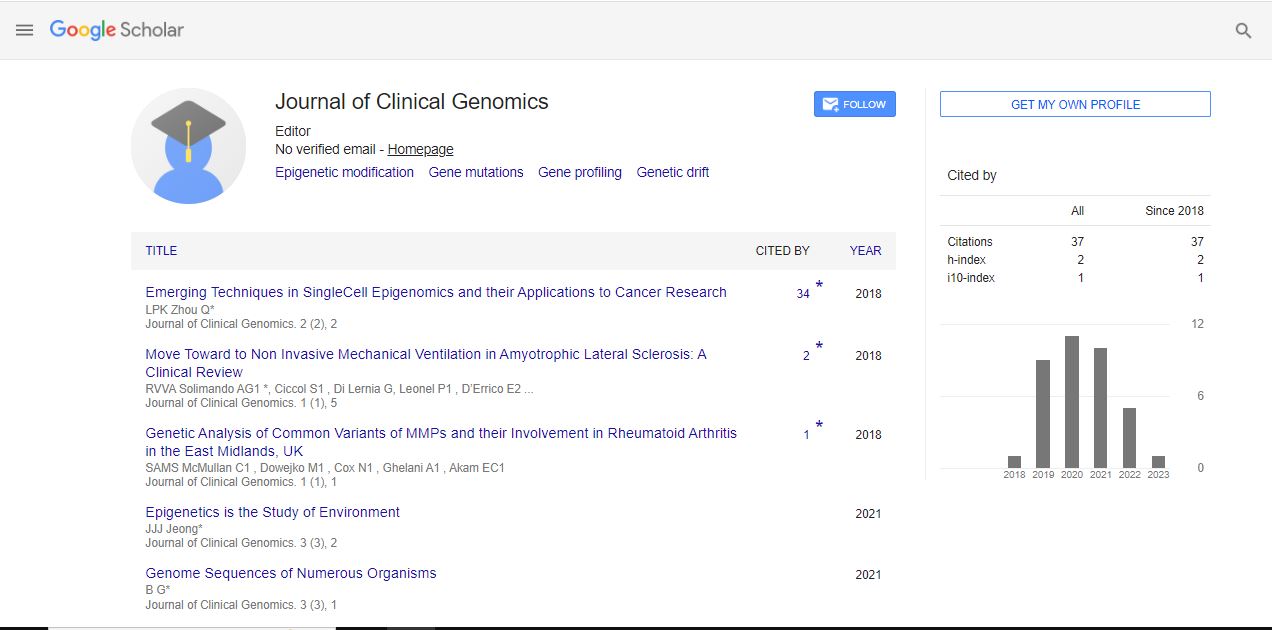Perspective, J Chromatography Res Vol: 6 Issue: 4
Hyphenated Techniques for Improved Separation of Analytes in Chromatography
Cai Yang*
1Innovative Institute of Chinese Medicine and Pharmacy, Shandong University of Traditional Chinese Medicine, Jinan, China
*Corresponding Author: Cai Yang,
Innovative Institute of Chinese Medicine and
Pharmacy, Shandong University of Traditional Chinese Medicine, Jinan, China
E-mail: yangcai78@sutcm.cn
Received date: 27 November, 2023, Manuscript No. JCGR-24-123796;
Editor assigned date: 29 November, 2023, Pre QC No. JCGR-24-123796 (PQ);
Reviewed date: 14 December, 2023, QC No. JCGR-24-123796;
Revised date: 21 December, 2023, Manuscript No. JCGR-24-123796 (R);
Published date: 28 December, 2023, DOI: 10.36648/JCGR.1000081.
Citation: Yang C (2023) Hyphenated Techniques for Improved Separation of Analytes in Chromatography. J Chromatography Res 6:4.
Description
Chromatography, a powerful analytical technique, has undergone significant advancements with the integration of hyphenated techniques. These combinations, often referred to as hyphenated chromatography, involve coupling chromatographic separation methods with various detection or sample preparation techniques. The synergy achieved through hyphenation enhances the overall analytical capabilities, providing improved sensitivity, selectivity, and efficiency in the separation and identification of analytes. This essay explores the principles, types, and applications of hyphenated techniques in chromatography for the enhanced separation of analytes.
Principles of hyphenated techniques
The core principle of hyphenated techniques lies in the seamless integration of two or more analytical methods to address the limitations of individual techniques. By combining the strengths of different separation and detection methods, hyphenated techniques offer enhanced analytical power, enabling the detection and quantification of trace compounds in complex samples. The coupling of chromatography with various detectors, spectroscopy, and mass spectrometry allows for a comprehensive analysis of diverse analytes.
Types of hyphenated techniques
Gas Chromatography-Mass Spectrometry (GC-MS) is one of the most widely used hyphenated techniques, combining the highresolution separation capabilities of gas chromatography with the sensitive and selective detection capabilities of mass spectrometry. This technique is particularly effective for volatile and semi-volatile compounds, providing detailed information about the molecular structure and fragmentation patterns of analytes.
Liquid Chromatography-Mass Spectrometry (LC-MS) combines the liquid chromatographic separation with mass spectrometric detection. It is versatile and applicable to a wide range of compounds, including polar and nonpolar substances. LC-MS is commonly employed in pharmaceutical, environmental, and biological analyses due to its ability to handle complex samples and provide high sensitivity.
Gas Chromatography-Infrared Spectroscopy (GC-IR) combines the separation power of gas chromatography with the identification capabilities of infrared spectroscopy. This technique is valuable for the analysis of compounds that exhibit distinct infrared absorption spectra, allowing for the identification of functional groups and structural elucidation. Liquid Chromatography-UV/Visible Spectroscopy (LCUV/ Vis) combines liquid chromatography with UV/visible spectroscopy for the detection of compounds with chromophores. This technique is widely used for quantifying analytes in various applications, including pharmaceutical and environmental analyses, where compounds absorb UV or visible light.
Ion Chromatography-Mass Spectrometry (IC-MS) couples ion chromatography, which separates ions based on their charge, with mass spectrometry for sensitive detection. It is particularly suitable for the analysis of inorganic and organic ions in environmental and biological samples. Liquid Chromatography-Nuclear Magnetic Resonance (LC-NMR) combines the separation capabilities of liquid chromatography with the structural elucidation capabilities of nuclear magnetic resonance spectroscopy. This technique is valuable for identifying unknown compounds and studying complex mixtures in detail.
Advantages of hyphenated techniques
Hyphenated techniques often provide increased sensitivity compared to standalone methods. The combination of separation techniques with highly sensitive detectors or spectrometers allows for the detection of trace amounts of analytes. By combining different separation methods, hyphenated techniques enhance selectivity. This is particularly beneficial in complex sample matrices where interferences can compromise the accuracy of analyses. Hyphenated techniques offer a more comprehensive analysis by providing both separation and detailed information about the structure and composition of analytes. This is crucial for the identification of unknown compounds in complex samples.
The integration of complementary techniques leads to increased overall efficiency in the analytical process. This is evident in reduced analysis time, improved sample throughput, and enhanced data quality. Hyphenated techniques are versatile and can be applied to a wide range of analytes, including small molecules, polymers, peptides, and large biomolecules. This versatility extends their utility across various scientific disciplines. Hyphenated techniques find extensive application in environmental analysis for the detection and quantification of pollutants, pesticides, and other contaminants in air, water, and soil samples. GC-MS and LC-MS are commonly used for such analyses due to their high sensitivity and selectivity.
In the pharmaceutical industry, hyphenated techniques play a crucial role in drug development and quality control. LC-MS and GCMS are employed for the analysis of pharmaceutical compounds, metabolites, and impurities, providing detailed information about drug formulations. Hyphenated techniques are utilized in the analysis of food and beverage samples for the identification and quantification of additives, contaminants, and flavor compounds. LC-MS, GC-MS, and LC-UV/Vis are commonly employed for such applications.
In clinical and biomedical research, hyphenated techniques are used for the analysis of biological samples, including blood, urine, and tissues. LC-MS and GC-MS are valuable tools for identifying biomarkers, drugs, and endogenous compounds. The characterization of polymers, including molecular weight determination and structural analysis, is facilitated by hyphenated techniques such as GPC-MS and LC-NMR. These methods provide insights into polymer composition and architecture.
 Spanish
Spanish  Chinese
Chinese  Russian
Russian  German
German  French
French  Japanese
Japanese  Portuguese
Portuguese  Hindi
Hindi 